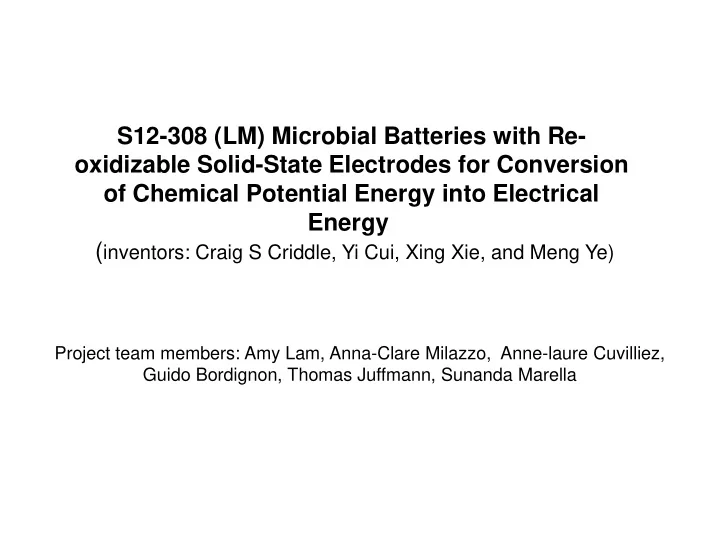

S12-308 (LM) Microbial Batteries with Re- oxidizable Solid-State Electrodes for Conversion of Chemical Potential Energy into Electrical Energy ( inventors: Craig S Criddle, Yi Cui, Xing Xie, and Meng Ye) Project team members: Amy Lam, Anna-Clare Milazzo, Anne-laure Cuvilliez, Guido Bordignon, Thomas Juffmann, Sunanda Marella
Waste water (l) # per day total (l) 30 1x 30 10 3x 30 0.5 6x 3 150 1/3x 50 . . . . . . . . .
Microbial batteries Summary
Does it work? Oxidation of organic matter Wastewater Electricity
Microbial fuel cell vs. microbial battery Microbial Microbial fuel cell battery
Potential Customers Wastewater Domestic Industrial Municipal Home Septic Wineries and Sugar Cane Many others Aquaculture Wastewater Systems Breweries Processing …
Wastewater Treatment Energy Available ~ 80k water/wastewater treatment plants www.waterworld.com
Energy Consumed Average Energy Used: 1,200 kWh/million gallons (MG) Energy Use Scales with 1 MGD 2,200 kWh/MG Size • -45% 10 MGD 1,200 kWh/MG • -17% 50 MGD 1,000 kWh/MG • www.ncsafewater.org
US EPA Energy Efficiency in Water and Wastewater Facilities
PSU ASU
Onsite wastewater treatment system – Septic systems • 20% of U.S Homes use septic systems to treat their wastewater (EPA) • Conventional methods using gravity flow – no energy costs, relatively cheap, anaerobic • Septic tanks need regular maintenance and lack of it leads to groundwater pollution
Potential applications for the microbial battery technology to be used in wastewater treatment in Septic systems • Two companies Emfcy and Proningeer are scaling MFC technology to be able to use it in onsite wastewater treatment • Using a greener technology might entail subsidies from The ARA (America Recovery Act - Kit Rosefield from California Onsite waste water association (COWA). • Energy generation from wastewater treatment in septic tanks will be of interest in developing countries without proper access to municipal sewers and electricity
Application: Microbial batteries in aquaculture • System types • 2004 EPA effluent guidelines • Information from “getting out of the building” step o Pathogen removal is key problem o Modularity/easy addition
Widmer Brothers‘ Brewery & Oregon State Fosters brewery & Univ. Queensland Anheuser-Busch & Cornell Univ.
Conclusion – Several Issues Remain • Additional R&D required – Cost high (materials, maintenance, labor, etc) – Efficiency low • Regulatory Considerations • Operational Considerations – Existing infrastructure
Recommend
More recommend